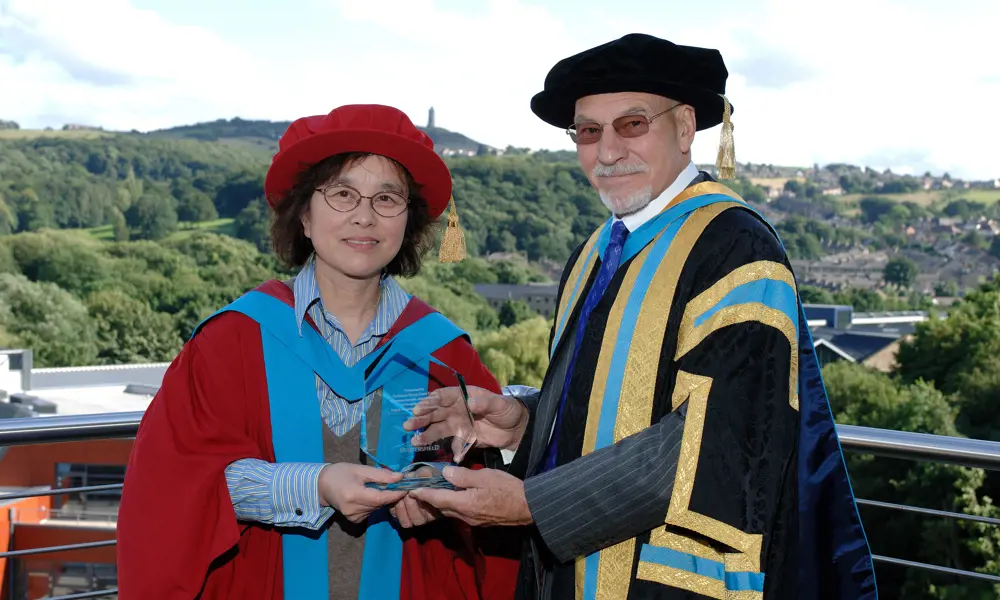
Integrating metrology in business and academe
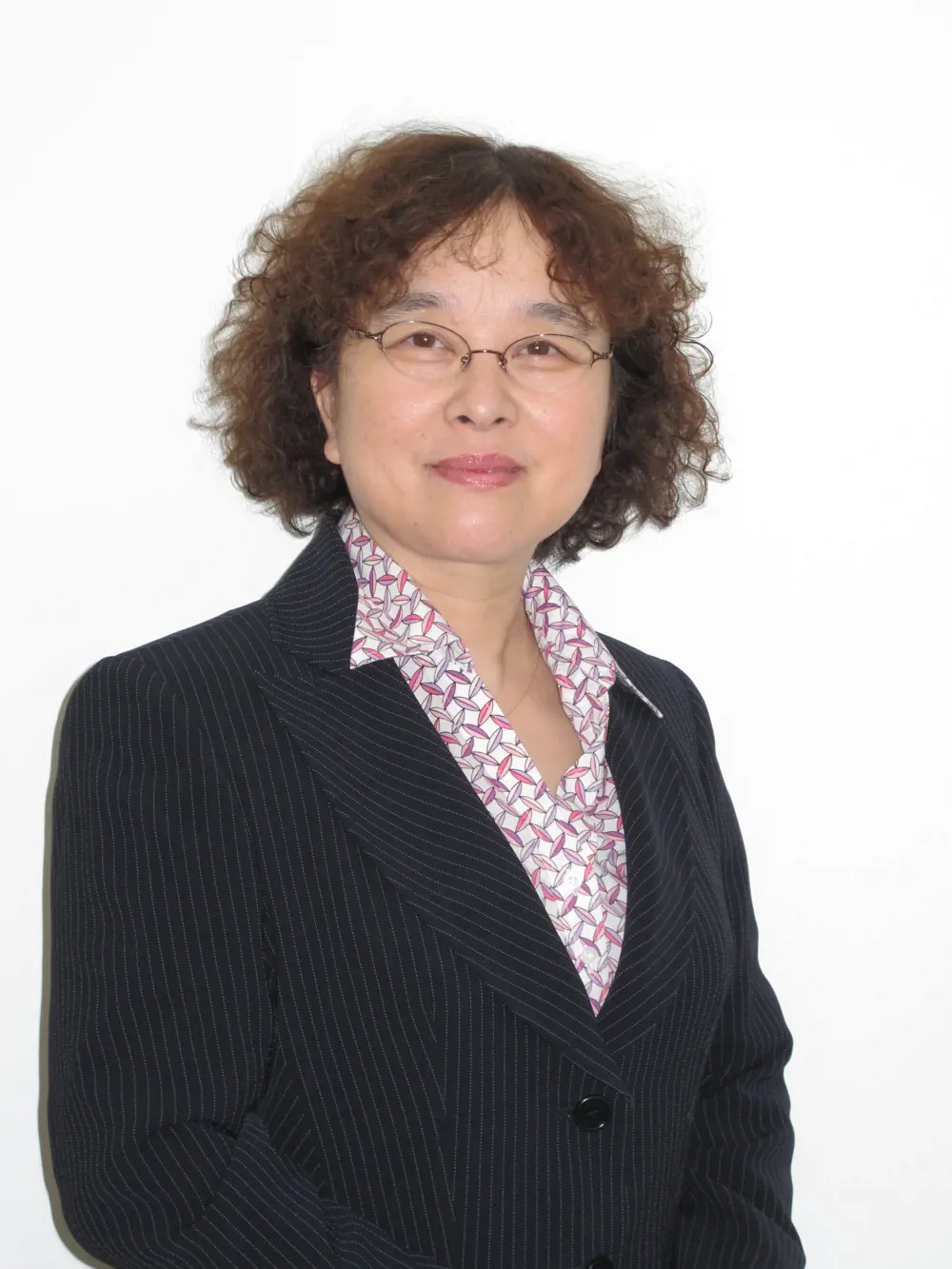
Professor Xiangqian (Jane) Jiang FREng
Professor Jane Jiang’s office at Huddersfield University has a collection of pictures, awards and souvenirs that demonstrate her successful wide-ranging international career in research. One unusual accolade for an academic’s wall is a scroll proclaiming Professor Jane Jiang FREng as a Freeman of the City of London, an honour bestowed on her in 2013 through the Worshipful Company of Scientific Instrument Makers. Jiang’s husband, the pioneering mathematical metrologist Professor Paul Scott, jokes that this gives his wife the right to take a flock of sheep over London Bridge whenever she should feel like it!
The scroll is just one indicator of how far Professor Jiang has come since Chairman Mao’s Cultural Revolution forced her parents away from their careers as doctors and academics in Shanghai in China. Exile from their home not only disrupted her parents’ lives, but seemed to end Jiang’s own hopes of following them into a life of learning, “the family tradition” as Jiang describes it. Instead, in 1970, the authorities put this bright 15-year old schoolgirl to work on a production line, in a factory assembling buses.
There can’t be many university professors without an undergraduate degree but when Jiang finally emerged from the bus factory after 20 years she made up for lost time by going straight for a masters degree followed quickly by a PhD
Professor Jiang’s atypical career path to academic research eventually brought her to Huddersfield as the director of one of the UK’s leading centres for metrology research. There can’t be many university professors without an undergraduate degree but when Jiang finally emerged from the bus factory after 20 years she made up for lost time by going straight for a masters degree followed quickly by a PhD.
Self taught
Professor Jiang’s escape from the production line began when she was told that she wasn’t physically up to heavy manual labour. Instead she was transferred to the factory’s drawing office. From there she moved up the ranks, as a technician and metrologist before becoming a fully qualified engineer.
This was a significant achievement for someone with no formal education in engineering – self-taught engineers rarely get that far. But even when she was working on the production line, Jiang had refused to give up on her ambitions. She attended night classes to catch up on her lost schooling. The classes did not cover engineering. “It was just like middle school,” she explains. So Jiang spent her own money on undergraduate text books to teach herself mathematics and engineering.
Jiang spent her own money on undergraduate text books to teach herself mathematics and engineering
Jiang attributes her rise through the system partly to the fact that her bosses saw in her someone bright who could tackle problems. As she puts it: “If people find that you are clever and will take the load off them, they just keep giving you new tasks”. In her case, these involved fixing problems on the production line. In particular, components often arrived from different factories that did not fit together properly on the line. The challenge, she explains, was to get factories to follow the same standards and to keep products and components to the same tolerances. “To keep the tolerances you need to measure, you need to specify,” she explains. This takes you straight into metrology, the science of measuring things.
For Jiang, the attraction of metrology is that it was a way to indulge her scientific interests. “Metrology is interesting for me because it requires mathematics and physics. It can go from the nano size to astronomy size, where you have very large machines and telescopes.”
Metrology is interesting for me because it requires mathematics and physics. It can go from the nano size to astronomy size, where you have very large machines and telescopes
What started for Jiang as a way of solving production line problems, devising equipment to measure particular components, grew into a wider expertise. At first, she came up with ways to measure a specific part and then generalised it. “Gradually I started to use instruments, like the coordinate measuring machine, which measures the physical geometrical characteristics of an object, to measure a range of things.”
This evolution from the specific to the general is in line with Jiang’s approach to problem solving. Asked what she would say to someone thinking of a career in metrology, she said: “A piece of advice would be to focus on a particular solution initially and then try to relate it to a universal requirement.”
In her own pursuit of solutions to measure things, Jiang produced several inventions that went on to win prizes in China, including a first-class award for provincial technology achievements and one for technological innovation.
In her own pursuit of solutions to measure things, Jiang produced several inventions that went on to win prizes in China
Even as a works engineer, Jiang was writing papers. Her early work included a series of lectures that were published for use at Changzhou Polytechnic College. Jiang’s publishing output now stands at more than 330 papers, including several best paper awards at major conferences.
For two decades, the authorities turned down her requests for permission to go to university. However, when she finally did make it, her rise was rapid. In 1990, Jiang passed the National Graduate Admission Examination with results so good that, even though she lacked a first degree, she was allowed to go to Huazhong University of Science and Technology in Wuhan to study measurement technology and scientific instruments to masters and doctorate level.
Jiang’s PhD led her to focus on the power of optical systems in metrology. Light allows instruments to probe surfaces without physical contact and she worked on the complex task of measuring the shape of “arbitrary” curved surfaces that have no obvious symmetry to latch on to. The approach involves utilises optical systems, using interferometry for example, to probe surfaces and then complex maths to study the shape of the surface.
She finished her PhD on Theory and method for measurement of curved surface topography in 1995. Along the way she had invented a cylindrical grating interferometer for surface measurement. This type of instrument has become the standard measurement technology in the aerospace and automotive sectors.
The Cultural Revolution had run its course by the time Jiang completed her PhD, and intellectuals were no longer suspect. In fact, the Chinese government now started to garland her with honours. In 1999, she won an award for China’s best engineering PhD dissertation. In the same year, the Ministry of Education awarded her a prestigious Cheung Kong Professorship, which was followed by the Outstanding Young Scientist award from the Chinese National Natural Science Foundation Council. By then, the wider research community had also started to notice Jiang’s work. In 1994, before she had completed her PhD, she spent a short time in the UK as a Royal Society Visiting Scholar. Two years later, she returned to these shores to take up the post of Research Fellow at Birmingham University. She had barely got used to the city when, with the promise of government money and a supportive university, the head of the group moved the team to Huddersfield, which enabled Jiang to build her own research group.
China Jiang was recognised as the “fifth most influential woman of Chinese origin”
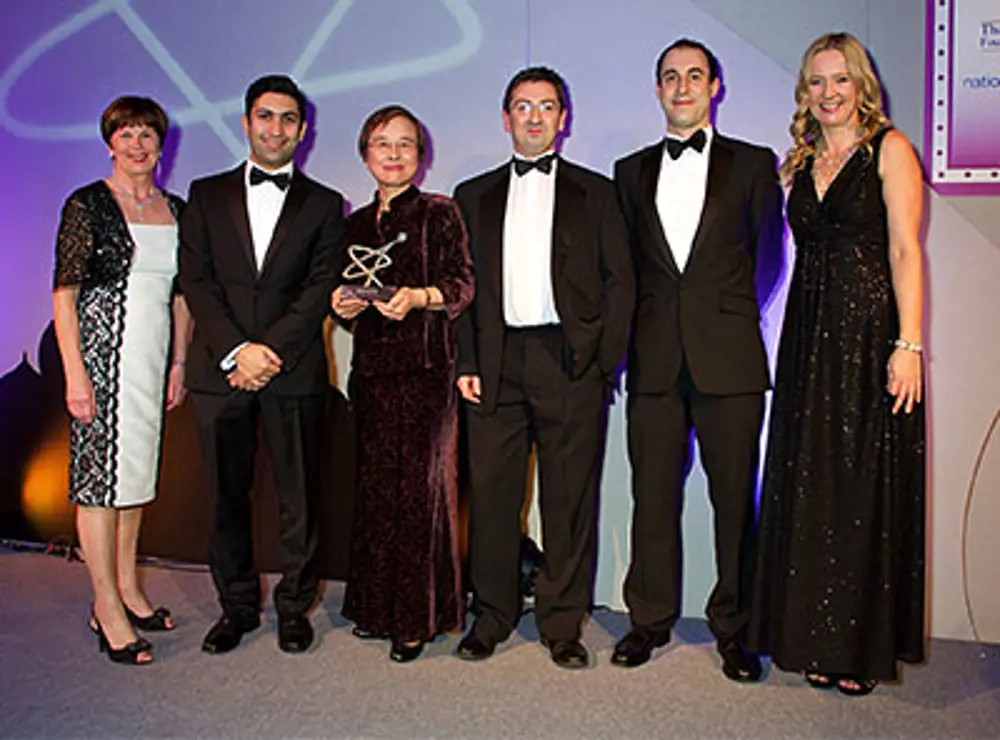
The University of Huddersfield’s EPSRC Centre for Innovative Manufacturing in Advanced Metrology won the Manufacturing Technology category of the 2014 Innovation Awards by the Institution of Engineering and Technology © IET
In 2003, she became a professor and head of the surface metrology group. This body steadily built up a reputation for its research and innovations while Jiang added to her shelf of awards. The recognition was both national and international. In 2006, she became the first Royal Society Wolfson Research Fellow. In the same year, she was awarded a UK national prize, the Outstanding Asian Woman of Achievement Award. Rounding up this award-winning year, back in China Jiang was recognised as the “fifth most influential woman of Chinese origin”. Her local role also received recognition that year, when she was made an Ambassador of Huddersfield.
Five years ago, she was appointed director of Huddersfield’s new Centre in Advanced Metrology. The centre, one of the EPSRC’s Centres for Innovative Manufacturing, has around 70 people working from bench-scale projects to large machine tools.
Just along from her own office, PhD students and postdocs work on the R&D side of fundamental metrology on a series of optical benches. During a tour of the optics lab, Jiang points out specific scientific instruments that her group needed to do its research. Money was tight when she set up the lab in the early 2000s. The group, with just £6,000 to set up a new lab, bought a lot of its initial equipment on eBay.
These days, the centre’s researchers have access to the latest hardware as they develop optical systems and write the all important software to process the data. The aim is to turn these proof-of-principle prototypes into hardware that is robust and reliable enough to make measurements on the machine tools and factory hardware in the building’s basement.
Optical metrology is an important aspect of their research, but getting it to work on production lines can be challenging. Originally, optical instruments were large, explains Jiang. “They needed very good conditions with no vibrations, because the measurement speed was slow. If it was too slow, the instruments would be affected by the slightest shake or thermal activity.” Thanks to advances in both electronics and optical systems, it is now possible to make sufficiently quick measurements with tailored maths used to process the data. Mathematics is the crucial link in this R&D chain between lab bench and factory floor.
there has to be a new generation of measurement devices and instruments that “will require accessibility into manufacturing environments, online, non-contact and high-speed operation combined with ease of use, a small footprint and robustness.”
Optical measurement systems have become increasingly useful when measuring small-scale electronics but this has set its own problems. Jiang says that “the scale of surface texture is beginning to approach some of the geometrical features in micro/ nano electro-mechanical systems devices”. In other words, how do you tell an electronic ‘feature’ on a chip from the underlying surface structure? Or what about measuring the uniformity – and effectiveness – of the surface of photovoltaic solar cells?
Jiang thinks that technological progress using surfaces like these won’t be possible unless “the associated manufacturing processes are rigorously controlled and the surfaces are measurable”. And for that to be possible, there has to be a new generation of measurement devices and instruments that “will require accessibility into manufacturing environments, online, non-contact and high-speed operation combined with ease of use, a small footprint and robustness.”
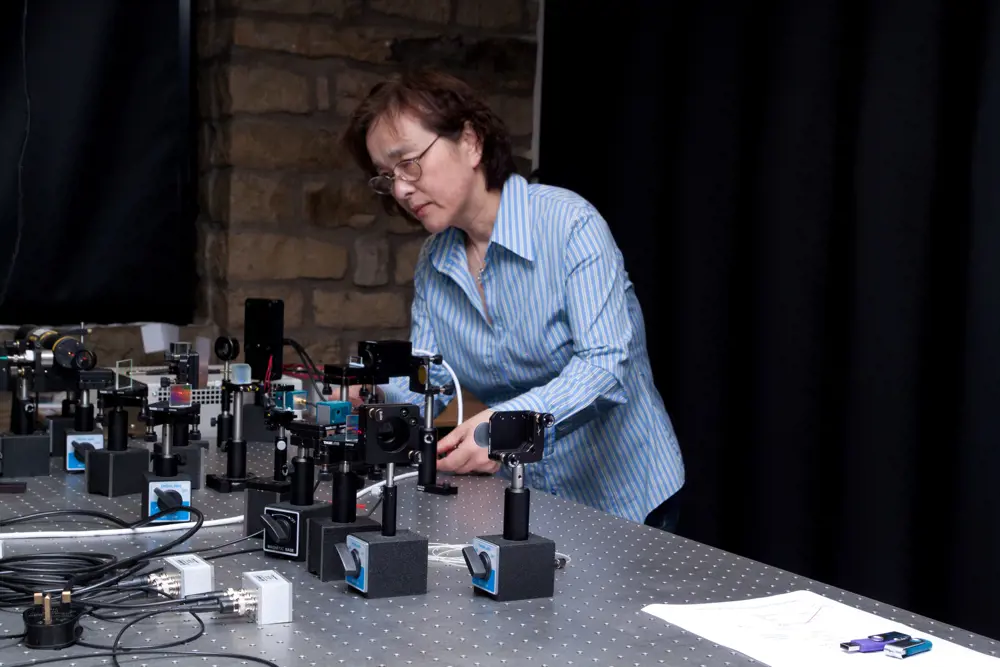
Professor Jane Jiang aligning optical apparatus for her team’s newest invention, the Dispersed Reference Interferometer. The target of this new measurement technology is to cover a 2mm + measurement range at nanometre resolution, with a measurement rate of up to 10 kHz
Business partners
Suppliers of instruments and metrology systems, one of the UK’s engineering successes, work closely with the centre. Taylor Hobson, a leading supplier of metrology systems for machine tools, for example, has licences to commercialise the metrology centre’s SURFSTAND software, developed for areal surface characterisation.
Another important partner with an interest in Huddersfield’s software is Renishaw, which has research staff seconded to Huddersfield. The company designs and sells probes for the machine tool market as well as measuring systems for chip makers. Jiang says: “Renishaw sells the probing, while Huddersfield contributes mathematical skills to compute the results. We pull together.”
Jiang is proud of the centre’s work with the UK’s manufacturers. It has carried out projects with Rolls-Royce, for example, which needs help to ensure that the turbine blades it makes are the correct shape, with the right surface structure. Here, the centre has done much to bring down the time it takes the company’s engineers to calibrate their production lines.
It can be expensive to take manufacturing equipment offline to check that the machinery is correctly calibrated to produce components to the required accuracy. Jiang talks enthusiastically about her team’s success in slashing the downtime on large machines from a fortnight to half a shift. “In half a day we can do everything.” In the past, she jokes, the company used to say that it could not afford to suspend production for calibration. “Now they say it is impossible not do it, because that way they keep the quality and the productivity”.
Rolls-Royce, Taylor Hobson and Renishaw, are just three of the hundred or so businesses that have worked with the centre
Rolls-Royce, Taylor Hobson and Renishaw, are just three of the hundred or so businesses that have worked with the centre, part of a wider supply chain for metrology, including many local businesses. Cummins Turbo Technologies, for example, is within walking distance of the centre. Jiang’s guided tour of her domain also takes in the facilities of NPL Huddersfield, the northern offshoot of the National Physical Laboratory, and its first facility outside its headquarters near London. Set up in 2008, NPL Huddersfield provides commercial calibration services that are very much in line with the metrology centre’s research expertise.
Career timeline and distinctions
Born, 1955. Apprentice, Draftsperson, Technician, Engineer, City Automobile Manufacturer, Changzhou, P R of China, 1970–1990. Research Fellow, University of Birmingham, 1996. Senior Research Fellow, University of Huddersfield, 1997. Cheung Kong (Yangzi) Distinguished Professor awarded by the Ministry of Education, P R of China, 1999. Outstanding Young Scientist, awarded by National Natural Science Foundation of China, 2000. Professor (Chair of Precision Metrology), Leader of Surface Metrology Group, Chief Scientist, Centre of Precision Technologies, University of Huddersfield, 2003. Elected Fellow of Chinese Society of Measurement and Instruments, 2004. Royal Society Wolfson Research Merit Award, 2006. Elected Fellow of the Royal Society of Arts, 2006. Elected Fellow of the Institute of Engineering Technologies, 2006. ERC Advanced Investigator Holder, European Research Council, 2009. Elected Fellow of CIRP – Collège International pour la Recherche en Productique, 2011. Elected Fellow of the Royal Academy of Engineering, 2012. Freeman of the City of London, 2013. Elected Fellow of International Society for Nano-manufacturing, 2013. Liveryman of the Worshipful Company of Scientific Instrument Makers, 2013. Sir Harold Hartley Medal, 2014. Renishaw/RAEng Chair in Precision Metrology, 2016.
New ambitions
The growth of commercial operations like NPL North underlines the value of having a cutting-edge research centre in the region. Jiang points out that the Huddersfield centre is surrounded by engineering companies that need to monitor and control the precision of their production lines. Jiang’s ambitions, backed by Huddersfield University, are to move the centre, now spread around the engineering department and the 3M Buckley Innovation Centre next door, which also houses NPL North, into a brand new building on the campus.
Bringing everything together would make it easier for Jiang to achieve another of her ambitions. She wants to eliminate the need for even half a day’s downtime for companies like Rolls-Royce.
The ultimate ambition is the ‘autonomous factory’
Her group is working towards ‘on-machine’ metrology, measuring what goes on during manufacturing. The ultimate ambition is the ‘autonomous factory’. The aim, says Jiang, is in-process inspection, at every stage, on the machine. The need for metrology in this ambition is why the Huddersfield centre has been a part of the EPSRC’s ‘factory of the machine’ initiative. “The idea behind this is that manufacturing and measurement go together,” she explains. Maybe Chinese bus factories would be open to such an approach when running production lines?
***
This article has been adapted from "Integrating metrology in business and academe", which originally appeared in the print edition of Ingenia 66 (March 2016).
Contributors
Michael Kenward OBE
Author
Keep up-to-date with Ingenia for free
SubscribeRelated content
Design & manufacturing
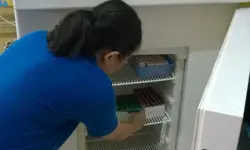
Super cool(er)
Welsh startup Sure Chill has developed a cooler that uses the properties of water to keep its contents cool for around 10 days without electricity. This is ideal for storing items such as vaccines where electricity sources are unreliable.
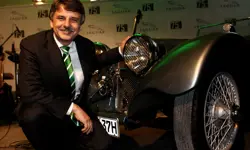
R&D investment makes good business sense
In just five years, Dr Ralf Speth FREng has presided over a revolution in design and manufacturing that has helped create a new family of engines and has overhauled Jaguar Land Rover (JLR) production facilities.

Steel can arise from the ashes of coal
Thousands of people were laid off in the UK steel industry in 2015 and there are pessimistic future forecasts. Professor Sridhar Seetharaman of the Warwick Manufacturing Group argues that smaller, flexible steel mills implementing new technology would better cope with fluctuating global trends.

Intelligent prosthetics
Prosthetic limbs can help many amputees regain independence and mobility. The Linx limb system, winner of the 2016 MacRobert Award, developed by Blatchford, has smart robotics that constantly monitor and adapt to movement, making walking and movement more natural for lower-leg amputees.
Other content from Ingenia
Quick read

- Environment & sustainability
- Opinion
A young engineer’s perspective on the good, the bad and the ugly of COP27

- Environment & sustainability
- Issue 95
How do we pay for net zero technologies?
Quick read

- Transport
- Mechanical
- How I got here
Electrifying trains and STEMAZING outreach

- Civil & structural
- Environment & sustainability
- Issue 95